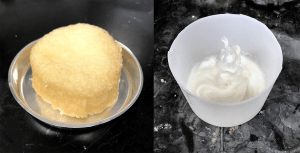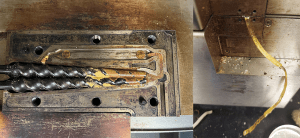Just Like Chocolate
Recycling plastics for a greener future
By: Molly Sun
Every day, I cook up something new – fresh biscuits, fettuccine, and even soft-serve ice cream. But none of my creations are edible. The fluffy biscuits are buttery-yellow polyurethane foam, deceptively warm and soft. The fettuccine noodles are long, brittle strands of polyurethane film with a snap as satisfying as their alfredo-smothered twins. As a polymer chemist, I make and study polyurethane in all their weirdly delicious forms to figure out not how to eat them (to my regret on dinnerless late nights in the lab), but how to consume them as recyclable plastics. As they are, none of my plastic creations are recyclable either – a deep problem for a hungry world saturated with plastic waste. While consuming our leftovers presents an appetizing solution, the puzzle lies in how to make our used polyurethanes palatable again.

Most plastics fall in a category called thermoplastics, meaning heat breaks down their molecular structure and makes them easy to reshape, like chocolate. For example, the polyethylene that makes up water bottles is a thermoplastic, so like chocolate, they are easy to melt down and mold into new shapes. The tiny molecular chains in thermoplastics are held together merely by weak electrostatic attractions, like strands of yarn bound to each other by a shock of winter static.
However, most polyurethane has a particular chemical structure that prevents it from being remolded like thermoplastics. Its molecular strings are locked together by chains known as crosslinks, as if strands of soft, pliable yarn were linked by metal chain links. The presence of crosslinks dramatically changes the properties of each type of plastic. This difference in structure gives a water bottle its crinkliness and a shoe sole its slight bend. Most polyurethane is a type of plastic known as a thermoset. Not even the most intense flames can dissolve the links, so toasting polyurethane is more akin to trying to melt breadcrumbs than chocolate; it creates a burnt mess.
The strength of polyurethane is both the source of its usefulness and its polluting potential. We use it in everything from mattresses and pleather to shoe soles and chairs — you’re likely wearing it and sitting on it right now. In 2018 alone, we produced 15.3 million tons of polyurethane, approximately the weight of the entire Giza Pyramid complex.

Unfortunately, the fate that awaits these mountains of plastic is not very green. Given the nature of its chemical crosslinks, polyurethane is too strong to recycle conventionally. Most of it ends up in our land, water, and air. If they aren’t simply thrown away or incinerated, the little polyurethane that does get reused is usually cut up and downcycled into lower-value products, such as building insulation and playground flooring. Though these products are useful, this is akin to cutting a yarn sweater into pieces and dunking them in glue to stick them back together – a Frankenstein of a plastic and not a true recycled product.
Researchers at Northwestern have figured out a promising new method for recycling polyurethane in bulk quantities, a previously unachievable goal that could prevent millions of tons of waste from making its way into our landfills. Through my research, I helped develop a recycling recipe where the key ingredient is a sprinkle of metal in the polyurethane soup. The strong crosslinks that hold polyurethane chains together may be unbreakable through recycling, but a gentler touch can pop crosslinks apart and put them back together, like Lego blocks. As it happens, recycling polyurethane resembles building just as much as it resembles cooking.
Polyurethane can be put back together, just as children restack their favorite Legos after knocking them down, by using certain forms of metals known as catalysts. After scientists mix polyurethane pieces with a metal catalyst, they can feed it to a device known as a twin-screw extruder. In this machine, two incredibly large, hot screws blast apart polyurethane on the molecular level.

The catalyst helps unlink the blocks, allow the melted plastic to swap linking partners, and relink the blocks to reform the polyurethane into solid plastic. Though the process completely rearranges the order of the building blocks in polyurethane, it still has similar properties to its original form. Once the recombination occurs, the twin-screw extruder squeezes out the soft polyurethane, and the polyurethane cools into a new shape. Whether they resemble noodles or rice crackers, these plastics are truly recycled, rebuilt pieces of plastic that may be re-moldable and reusable.
This method could help society rethink how we recycle, but there’s a few steps left to tweak in our recipe. The choice of catalyst is especially important. Previous research shows that dibutyltin dilaurate, a tin-based catalyst, is quite good at putting polyurethane back together. However, it’s also a neurotoxin for humans and animals – a red flag in a green project. Since there is currently no other way to meaningfully recycle polyurethane in bulk quantities, we are exploring suitable alternatives. Non-toxic catalysts based on elements like zirconium or nitrogen present a promising ways forward.
Transforming plastic into biscuits and noodles is not just a chemical magic trick, it’s changing abject trash into sustainable treasure. Creating a new way to consume plastic like polyurethane can satisfy both the human hunger for junk and the greater global appetite for conserving resources, value and our environment.
Molly Sun is a PhD candidate in chemistry at Northwestern University, studying new ways to recycle plastics through dynamic chemistry.
This story was produced as part of the SCIMEDIA_517 course in Skill and Careers in Science Writing.

